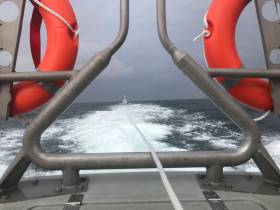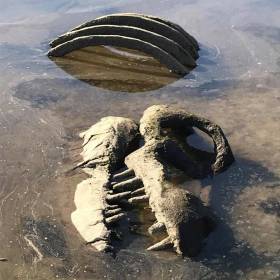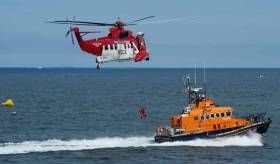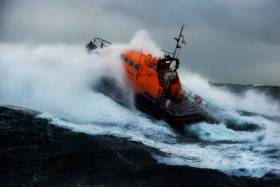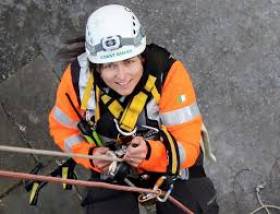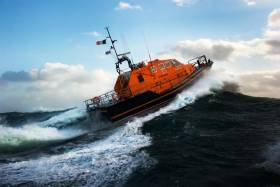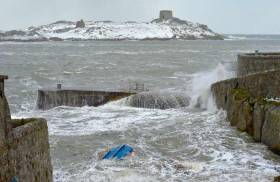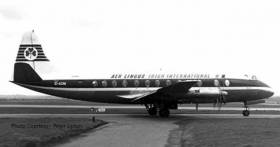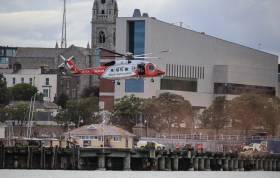Displaying items by tag: Coastguard
Wicklow Lifeboat Assists Fishing Vessel With Engine Failure
Wicklow RNLI volunteers were alerted by pager at 1.05pm on Friday afternoon (12 April) following a launch request to assist a fishing boat with engine failure.
The all-weather lifeboat Jock and Annie Slater put to sea shortly before 1.15pm under the command of coxswain Nick Keogh and proceeded towards the vessel, which was reported to be 23 miles north-east of Wicklow Harbour.
The lifeboat was alongside the 10-metre fishing boat an hour later. Conditions in the area were good, with south-easterly Force 3 winds.
The fishing vessel with three crew had developed mechanical problems and had lost propulsion. A towline was secured, and the vessel was towed back towards Wicklow over the next three-and-a-half hours, being secured safely alongside the North Quay shortly before 6pm.
This was the third callout since the all-weather lifeboat Jock and Annie Slater went on station at Wicklow on Friday 5 April.
Earlier in the week, Kilkeel RNLI’s volunteer crew launched at 4.20pm on Wednesday (10 April) to respond to a call from the skipper of a fishing boat that a semi-submerged kayak was adrift at Leestone Point, north east of Kilkeel Harbour.
Conditions were good and the crew arrived quickly on scene. On examination of the kayak, the crew found there was an algae growth on her bottom and no signs that it had been recently occupied.
With no reports of a missing kayaker, the kayak was taken on board the lifeboat which then returned to the station. Kilkeel Coastguard were in attendance.
Speaking afterwards, John Fisher, Kilkeel RNLI lifeboat operations manager, said: “It is important that if a small craft is lost or abandoned that it is reported to the coastguard. This will prevent any further reports by concerned members of the public or other persons.”
Mystery Of ‘Dinosaur Bones’ Found In River Boyne
Drogheda Coast Guard had a prehistoric mystery on their hands earlier this week with what the station is calling “probably the most unusual tasking we ever had or ever will have”.
The coastguard team were tasked on Tuesday (26 February) after an emergency call reporting ‘dinosaur bones’ in the River Boyne close to Drogheda town centre.
And indeed when they arrived the volunteers discovered what appeared to be the skeletal remains of a Tyrannosaurus rex half-submerged in the mud.
But on closer inspection, the bones were revealed to be “a very impressive imitation”.
Drogheda Coast Guard officer in charge Dermot McConnoran told TheJournal.ie that the plaster-cast bones were covered in silt suggesting they’d been in the river for some time.
Further research has turned up images of the same skeleton “in a less river-worn state” from a little over a year ago. It’s not yet known who is responsible for its creation.
Coast Guard Conducts Over 1100 Missions, 400 Lives Saved
In an end of year review, the Coast Guard is continuing to highlight the capacity to Raise the Alarm and Stay Afloat as essential elements to reducing loss of life owing to drowning’s at sea or on inland waterways.
The Coast Guard’s core safety message is Stay Afloat –Stay in Touch highlights the importance of never engaging in any commercial or recreational boating activity without wearing a fully serviced Life Jacket or Personal Flotation Device coupled with a capacity to raise the alarm via means such as a VHF radio, Personal Locator Beacon or mobile phone. This should be supported by informing a colleague of your anticipated return time.
"Coast Guard Helicopter provide broad range of services"
Into 2019 the Coast Guard will continue to focus on the importance of Prevention as a core theme of drowning prevention and will continue to work with colleagues in Irish Water Safety, RNLI and the Irish Sailing Association in promoting water safety and identifying key risk areas. In early 2019 it is intended to re-launch the Safety on the Water website.
 Wicklow RNLI Lifeboat operating at Wicklow Head Lighthouse Photo: Afloat.ie
Wicklow RNLI Lifeboat operating at Wicklow Head Lighthouse Photo: Afloat.ie
The Coast Guard’s three rescue Coordination Centres at Malin Head, Valentia Island and Dublin operate on a 24/7 basis. In the past year, the three centres managed a total of 2650 incidents which saw a rise when compared to 2017 (2503 incidents). MRCC Dublin also serves as the national single point of contact for processing Electronic Satellite-based Safety Alerts generated by EPIRBs, PLBs and ELTs. (Emergency Position Indicating Radio Beacon, Personal Locator Beacon and aircraft Emergency Locator Transmitters).
In 2018 MRCC Dublin processed a total of 137 electronic transmissions the majority of which proved to be false arising from accidental activation or out of date equipment no longer in service. The Coast Guard emphasises that this should not detract from their value and highlighted the importance for all users being familiar with their operation and inbuilt test mechanisms.
Key Message – ‘Stay Afloat – Stay in Touch’
Coast Guard helicopter services are provided under contract by CHCI operating a fleet of Sikorsky S92 helicopters out of bases in Dublin, Shannon, Waterford and Sligo. Helicopter services at each of the Four bases are on 15-minute notice by day and 45 minutes by night. In addition to their primary role of provision of maritime search and rescue services the Coast Guard provides a round the clock medical evacuation service to the offshore islands. In 2018 the Coast Guard flew a total of 102 medical missions from islands to the mainland, 35 more than in 2017. In addition Coast Guard helicopters conducted 8 Long Range offshore medical evacuations in addition to coastal and inshore search and rescue missions.
Coast Guard helicopters also provide HEMS (Helicopter Emergency Medical Service) to the HSE/National Ambulance Service including inter hospital transfers. The busiest inter hospital transfer routes are from the Letterkenny and Sligo to University Hospital Galway.
By year-end Coast Guard helicopters will have flown in excess of 670 missions, of which 119 were conducted on behalf of the Health Service Executive. Coast Guard helicopter services also include inland searches for missing persons and medical evacuations in support of An Garda Síochána and Mountain Rescue Teams.
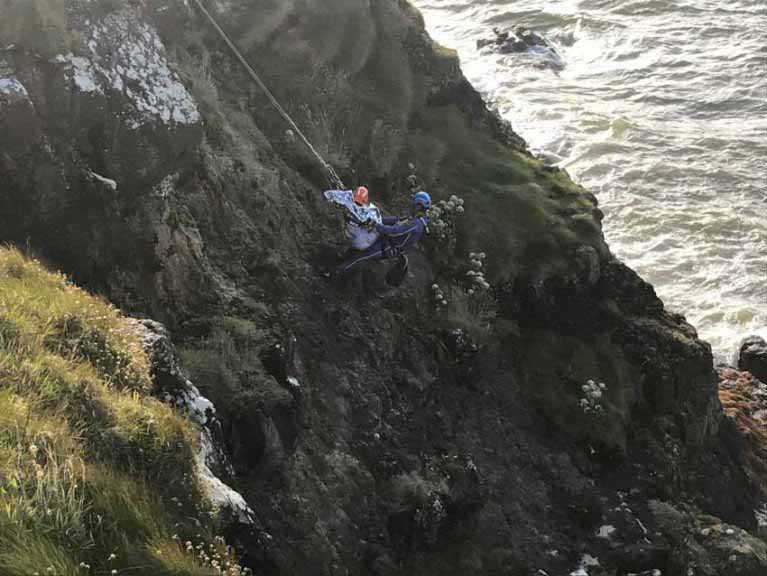 A cliff rescue conducted by the Coast Guard
A cliff rescue conducted by the Coast Guard
The nationwide network of Volunteer Coast Guard units continue to be an integral part of the national Search and Rescue framework. With a membership of circa 1,000 volunteers, the units deliver rescue boat, cliff rescue and shoreline search services coupled with a capacity to support their communities during local emergencies such as inclement weather. These community services were to the forefront during storm Emma in March when major challenges were experienced in reaching essential services. Coast Guard volunteers provided emergency transport to Health Care staff, conducted patient transfers and provided support to isolated homes. Overall Volunteer Coast Guard units were tasked on a total of 1185 separate occasions throughout the year.
Coast Guard Director Chris Reynolds said: “I want to particularly acknowledge the commitment and professionalism of our Volunteer members. In addition to the three core services that they provide they are an integral part of community resilience and continually act as the Eyes and Ears of our RCCs in assessing and responding to any coastal emergency.
The RNLI is categorised as a declared resource to the Coast Guard which means that each individual station can be directly requested to respond to individual incidents. In 2018 the RNLI were requested to launch on 836 occasions.
The Coast Guard attaches particular attention to what is categorises as Lives Saved. *This refers to assistance provided that was it not available would have resulted in loss of life or severe risk of loss of life or protracted hospitalisation. In 2018 the Coast Guard has recorded that in excess of 400 people were categorised as Lives Saved in comparison with 340 in 2017.
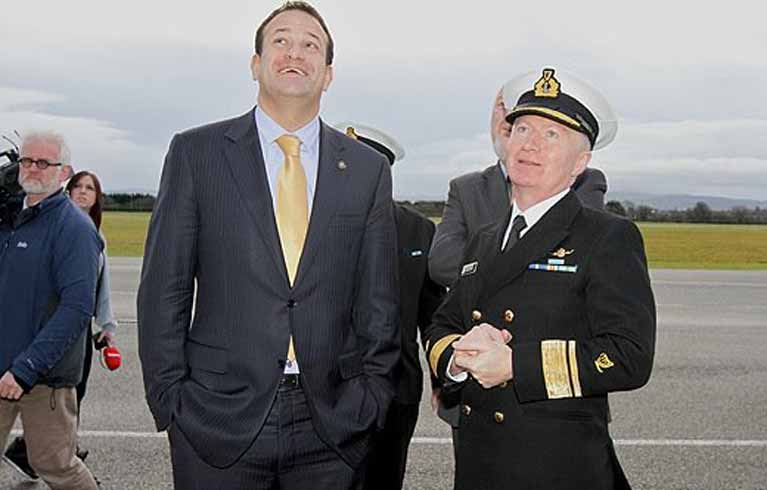 Coast Guard Director Chris Reynolds (right) with An Taoiseach Leo Varadakr
Coast Guard Director Chris Reynolds (right) with An Taoiseach Leo Varadakr
Director Chris Reynolds reiterated a core message of raising the alarm in time.
“If you can raise the alarm and you can stay afloat then you have an outstanding chance of being rescued by our world class rescue service.”
“If you see somebody in trouble or if you think they are in trouble at sea, on the water or along the coast Dial 112 and ask for the COAST GUARD.”
Irish Coast Guard & RNLI Issue Joint Water Safety Call This Christmas
The Irish Coast Guard and the RNLI, in the run-up to the Christmas period, are reminding the public to look after their personal safety when engaged in any water or coastal based activities.
They have issued a joint safety message reminding the public to heed simple safety advice when they are out on the water or engaged in any activity along the water’s edge. The two organisations have cautioned that many accidents and tragedies take place involving people who never expected to end up in the water.
There are some key pieces of advice that the RNLI and the Irish Coast Guard ask people to keep in mind when they are around the water over the Christmas and New Year break:
Stay Back – Stay High – Stay Dry when engaged in coastal walks and avoid any unfamiliar routes and be mindful of changes caused by coastal erosion and the risk of trip, slips and falls.
Ensure that pets are kept under control in case they get into difficulty and cause owners to risk their own safety in rescuing them.
Remember to carry a suitable means to call for help such as mobile phone, vhf radio or Personal Locator beacon
If engaged in any boating activities Do Wear an appropriate personal flotation device – it could save a life.
If going out alone, tell someone ashore your plans and what time you expect to be back.
For anybody engaged in a Christmas or New Year swim only participate in an organised swim that has appropriate safety facilities
Always remember if you see anybody in trouble on the water or along the coast or if you think they are in trouble Ring 112 and ask for the Coast Guard.
The RNLI’s ‘Float to Live’ message advises people who fall into cold water unexpectedly to fight their instinct to swim until the cold-water shock passes.
They should pause, and float on their back until able to catch their breath and either call for help or swim to land if it is nearby. The Coast Guard is reiterating its message to Stay afloat – Stay in Contact, meaning that if they can stay afloat and raise the alarm then they have an excellent chance of being rescued.
Irish Coast Guard Operations Manager Gerard O’Flynn said, ‘at this time of year people love to get out and about. Do so safely and act sensibly and wisely and if in doubt shout. Coast Guard services, will be fully operational over the holiday period.”
RNLI Lifesaving Manager Sean Dillon said, ‘It is much easier than people realise to get into trouble in the water. Whatever activity you are doing, make sure you are aware of the dangers, know your limits and do not take risks. Over the previous ten years, from Christmas Eve to New Year’s Day, RNLI lifeboats launched 137 times and assisted 57 people in Ireland. While all the search and rescue services stand ready to help people, being prepared and taking some basic safety advice can avoid an accident or a serious tragedy.’
In conclusion, both Sean and Gerard, wish all RNLI and Coast Guard volunteers, their shore-based support teams and staff, a happy and safe Christmas. Volunteer lifeboat and coast guard crews remain on call over the Christmas period.
Caitríona Lucas MCIB Report Will Accelerate Advances in Coast Guard Safety Management Systems
The Marine Casualty Investigation Board has today published its report into the marine incident on 12th September 2016 which led to the Coast Guard volunteer, Caitríona Lucas, tragically losing her life.
Minister Ross said: “I wish to again express my deepest condolences to the family and loved ones of Caitríona, who lost her life so tragically, doing the volunteer work she loved. Caitríona was a talented, hardworking and deeply committed member of the Doolin Coast Guard Unit. She was a selfless member of a unique group of people, those men and women who dedicate themselves to the protection of others at great risk to themselves. Caitriona made the ultimate sacrifice and her loss has been enormous. Coast Guard volunteers, in particular the direct colleagues of Caitríona in the Units at Doolin and Kilkee, were devastated at the tragic events that unfolded on that day.”
Minister Ross welcomes the report’s recommendations in full and will be ensuring that they are all implemented. These are clearly aimed at minimising the potential risks involved in SAR boat operations into the future.
The Minister also notes that as there is a separate on-going investigation being carried out by the Health and Safety Authority that it would not be appropriate for him to comment on the detail cited in the report.
Minister Ross said:
“As an immediate response to this report, I have taken the following steps:
1) I have broadened the national SAR Framework review already underway as a response to the recent AQE Report on SAR aviation. It will now encompass the relevant recommendations arising from the MCIB report. The Review Group itself met formally on Wednesday 5 December under the independent chairmanship of Sir Alan Massey, former CEO of the Maritime and Coastguard Agency in the UK.
2) I have instructed the IRCG to accelerate its work in developing an independently accredited ISO safety management system that will be robust and fit for purpose. This work is already underway and significant effort and investment has taken place over the last two years.
3) That said, I am requiring the IRCG and the Marine Survey Office to take the necessary and pragmatic steps to ensure that any issues which could impact on vessel or crew safety are addressed as a matter of urgency.”
The Minister concluded:
“Caitríona Lucas was an extraordinary woman - brave, committed, supremely generous – and her death was an appalling tragedy. Her life will be remembered by the actions of all those involved in Search and Rescue activities. I know the Irish Coast Guard including its 900 volunteers are committed to honouring her memory. We will ensure volunteer safety remains at the heart of Search and Rescue operations”.
RNLI & Irish Coast Guard Issue Joint Call for People to Stay Safe on the Water this May Bank Holiday
The RNLI and the Irish Coast Guard are issuing a joint call this May Bank Holiday weekend for people to stay safe on and near water as the expected warmer weather and brighter evenings will see more people spending time outdoors. The maritime organisations caution that an improvement in the weather does not mean warmer water temperatures and people should make sure they apply common sense and observe basic safety precautions when engaged in any activity either at sea or along the coast.
While the temperatures increase, Irish waters rarely exceed 15C, making them cold enough year-round to trigger cold water shock, which causes the instinctive reaction to gasp and swim hard, which can quickly lead to drowning. Over half of accidental coast drownings happen to people who never though they would end up in the water and are not prepared for an emergency.
The Irish Coast Guard and the RNLI are asking people to take the time to check that they have all essential safety equipment and that is fully serviced and that anybody who needs to use it knows what to do.
Always wear the correct equipment for your activity and always wear a lifejacket or proper personal floatation equipment
The RNLI and Coast Guard recommend attaching a Personal Locator Beacon (PLB) to your Lifejacket or Personal Floatation Device. The small devices are worn on your person and can send a distress message to the Coast Guard from any location.
Always tell another person where you are going and when you will be back
If you see someone get into difficulty dial 112 or 999 and ask for the Coast Guard. If possible look for something that floats or that they can hold on to and throw it out to them.
Check that all your safety equipment is working and fully serviced
Sean Dillon, RNLI Lifesaving Manager said: ‘The May bank holiday is traditionally a time when a lot of people get out and enjoy the coastline and our beautiful loughs and lakes. Last year Irish lifeboat crews launched 1,145 times to all types of incidents. The RNLI’s ‘Respect the Water’ campaign will be running throughout the summer but drowning prevention should be carried out year round.’
Gerard O’Flynn, Irish Coast Guard Operations Manager added: ‘If you are getting into a boat our message is ‘Stay afloat – Stay in contact’. Always wear a PFD or Lifejacket and ensure that you can raise the alarm if you need assistance be that by marine VHF radio, mobile phone or PLB (Personal Locator Beacon), which will enable responders to quickly locate and assist you”
IF YOU SEE SOMEBODY IN DIFFICULTY OR THINK SOMEBODY IS IN DIFFICULTY DIAL 112/999 and ASK FOR THE COAST GUARD
The community of Erris and Irish Coast Guard have been jointly honoured at the People of the Year Awards, with special recognition for the crew of Rescue 116 which was lost off the Mayo coast in March of last year.
The honour at the 43rd People of the Year Awards, organised by Rehab, was presented by broadcaster Bryan Dobson in recognition of the heroic work of the men and women of the Irish Coast Guard in risking life to assist maritime and coastal communities, while the people of Erris were recognised for their contribution to the search for the missing crew. The Awards were broadcast live on RTÉ One from Dublin’s Mansion House on Sunday.
Volunteer member Caitríona Lucas, who lost her life off the Clare coast during a separate operation, was also honoured.
It was early on the morning of March 14, 2017, that Coast Guard helicopter Rescue 116 disappeared off the north coast of Mayo. The aircraft had been providing communications support for an offshore medical assistance operation. On board were Capt Dara Fitzpatrick, Capt Mark Duffy and winch team Paul Ormsby and Ciarán Smith.
Hundreds of volunteers, fishermen, and colleagues supported the emergency services in combing the area for the missing crew, going above and beyond in a bid to recover the lost heroes.
The bodies of Dara Fitzpatrick and Mark Duffy were recovered in the subsequent searches. However, tragically and despite intensive efforts, the bodies of Ciarán Smith and Paul Ormsby have yet to be recovered.
Just six months previously, the Irish Coast Guard community had suffered another devastating loss with the passing of their brave colleague, volunteer member Caitríona Lucas, who had been participating in a search operation off the coast of Kilkee, Co. Clare.
Irish Coast Guard Search and Rescue Operations Manager, Gerard O’Flynn, said: “The selfless actions of those who put their lives on the line, for the safety of others, means Caitríona, Dara, Ciáran, Mark and Paul will remain an inspiration to us all. Going above and beyond is the norm for members of the Coast Guard service. The fact that these men and women often put their own lives in danger to carry out their duties makes the search and rescue crews such a remarkable group of people. Our colleagues will always be sadly missed and we remain deeply saddened by the depth of this tragedy.
“I would like to pay tribute to the community of Erris who left no stone unturned in supporting one of the most extensive search and investigation operations ever conducted in the area. Every possible assistance was provided, ranging from the fishing community providing local knowledge and advice, shoreline searching and, in particular, the huge catering operation that was put in place to provide valuable sustenance to all participants. It was indicative of the long-established bond between coastal communities and the Coast Guard services. We are humbled to receive this award which honours the bravery of all of our colleagues and pray that their bereaved families will take courage from this recognition.”
Ireland’s longest-running and most prestigious awards event, the People of the Year Awards are widely recognised as one of Ireland’s highest accolades. Nominated by members of the public, and finalised by a panel of adjudicators, a total of ten awards were presented at the ceremony which was hosted by Gráinne Seoige and Aidan Power.
Irish Coast Guard & RNLI Issue Joint Call for Caution Around Coastal Areas & Rivers After Storm Emma
In the aftermath of storm Emma and the heavy snowfalls around the country the Irish Coast Guard and the RNLI have issued a joint call for people to exercise caution and remain vigilant around the coast and near rivers. High tides, onshore easterly winds and a sharp rise in river levels could pose a significant risk to public safety.
Although river levels have been relatively low, a quick thaw coupled with heavy rainfall could result in a surge in water levels without warning. High tides assisted by non-prevailing winds as forecasted for the East coast may result in flooding and extreme danger on exposed piers and coastlines. The public should exercise caution and stay away from piers, harbours, seawalls and riverbanks.
Up to date weather event information can be viewed on www.gov.ie
Owen Medland, RNLI Area Lifesaving Manager said, ‘ It’s been a tough few days for the country and people will want to get out and about as soon as the weather moderates. ‘Many people rescued by RNLI lifeboat crews had no intention of entering the water in the first place. All too often, people’s first instinct when they see someone in trouble in the water is to go in after them. If you see someone in danger, dial 112 and ask for the Coast Guard straight away. Look for a ring buoy or something that floats that they can hold on to and throw it out to them.’
Irish Coast Guard Search and Rescue Operations Manager Gerard O’Flynn added, “The advice of the Coast Guard is simple, Stay Back, Stay High Stay Dry. Coast Guard teams around the country have been very busy providing support to the emergency services over the past few days. Please heed the warnings and be mindful of the risk posed by a surge in river levels following the expected thaw and be mindful of the risks on exposed coastal areas”.
Aer Lingus Tragedy To Be Commemorated at Rosslare
The 50th anniversary of the St.Phelim Aer Lingus tragedy in which the 4 crew and 57 passengers all died is to be commemorated at Rosslare on Saturday, March 24 next. There will be a wreath laying ceremony at the crash site with a Naval Vessel, the RNLI, Irish Lights, Irish Coastguard and other agencies present. A number of relatives will be taken to the site by the Navy for the ceremony. This will be followed by a Memorial Ceremony at Rosslare Harbour Memorial Park, writes Tom MacSweeney.
The tragedy occurred on March 24, 1968.
Aer Lingus flight EI 712 had left from Cork Airport at 10:32 a.m. on a direct service to Heathrow Airport, London and was cleared to fly at to FL170 (17,000 feet). The crew sent out a radio message at the Bannow reporting point at 10:57 local time stating they were at FL170.. They were instructed to change frequency to London Airways. Just eight seconds after first reporting to London Air Traffic Control a broken message was received which was later interpreted as ”Twelve thousand feet descending spinning rapidly. “The Viscount plane descended and struck the sea 1.7 nautical miles from Tuskar Rock. After the loss of contact, Air Traffic Control requested that Aer Lingus flight EI 362 which was heading to Bristol from Dublin to divert to an area west of the Strumble to see if they could spot anything on the water. They descended to 500 feet but nothing was seen.
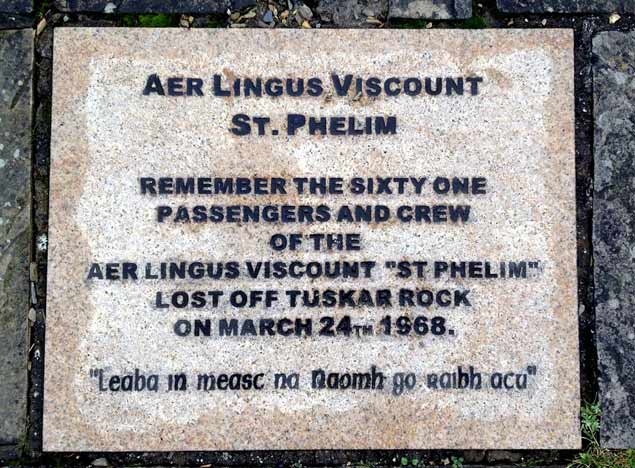 Rosslare memorial stone
Rosslare memorial stone
At 11:25 a.m. a full alert was sounded. HMS Hardy, a Royal Navy Type 14 Frigate was the first ship to reach the possible crash area but found nothing.
It wasn’t until the search resumed on the following day that floating debris was sighted and over the next few days a total of fourteen bodies were recovered. The main wreckage was detected on the seabed by a trawler at a depth of 39 fathoms (234 feet/71.3 metres), 1.7 miles from Tuskar Rock.
Sean Boyce of the Rosslare Maritime Museum and the organising committee said:
“It is our hope to have as many of the relatives as possible in attendance. There will be a commemorative display which we are happy to open to the families.”
PLANNED PROGRAMME OF COMMEMORATION
10:40 a.m. Boarding the Naval Vessel
11:00 a.m. Naval vessel/Flotilla departs to the Tuskar site.
11:45 a.m. Wreath Laying Ceremony on Site.
12:45 a.m. Arrive back at Rosslare Harbour – Bus back to Hotel Rosslare.
13:00 a.m. Lunch – Hotel Rosslare
2:30 a.m. Flag ceremony –Raising of flags/half-mast/Irish/ Belgian/Swiss /UK/US
2:40 p.m. Ecumenical Service
3:00 p.m. Wreath laying ceremony / unveiling.
3:20 p.m. Speeches.
3:45 p.m. Raising of the flags, Reveille. National Anthem.
4:00 p.m. End of cermonies
For more information the Facebook St.Phelim Air Crash 50th Commemoration Page here
Air Accident Investigation Unit Statement on R116 Investigation
The AAIU Investigation into the accident involving the loss of R116 and its four crew members at Blackrock, Co. Mayo on 14 March 2017 is still in the process of gathering factual and background information and is making steady progress. The AAIU again extends its condolences to the families and friends of those who lost their lives in this accident. International Convention, and associated National and European legislation, require that, if a final report cannot be made publicly available within 12 months of the date of the accident, an interim statement detailing the progress of the investigation and any safety issues raised, will be made publicly available.
The AAIU wishes to advise that due to the depth and breadth of this Investigation, it will not be possible to issue a final report within 12 months of the date of the accident and therefore an interim statement will be published. The Investigation is endeavouring to issue this interim statement before the anniversary; however, it is not possible to say at this time when the interim statement will be published.


























